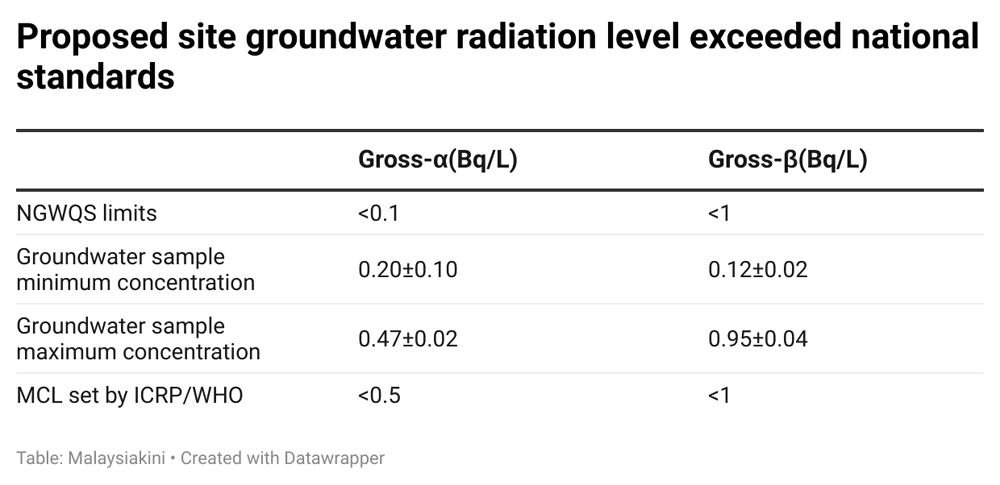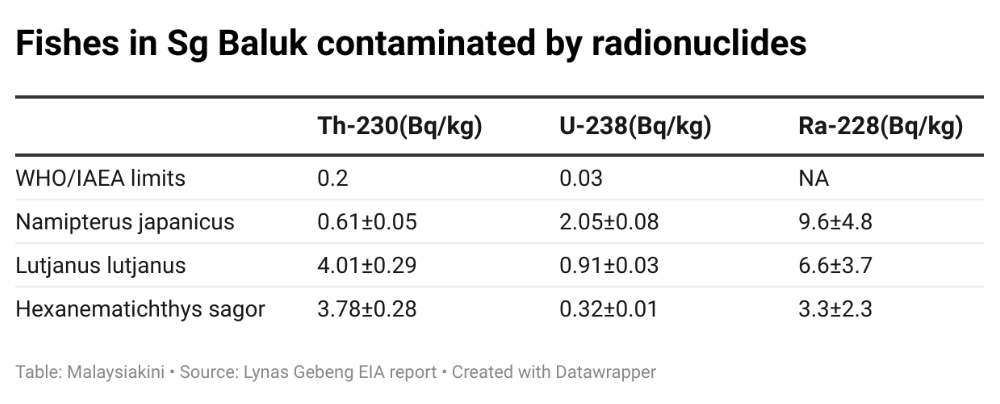When Australian miner Lynas Rare Earth decided to operate in Malaysia, the move was met with strong public opposition and critics often cited the Bukit Merah Asia Rare Earth (ARE) incident four decades ago in Perak.
Although Lynas has insisted its operation complies with regulations and that the radiation is less than that of the decades-old incident, the spectre of Bukit Merah continues to haunt it.
The recently published environmental impact assessment (EIA) report on Lynas’ proposed permanent disposal facility (PDF) project in Gebeng, Pahang, drew a comparison with ARE’s long-term storage facility in Bukit Kledang, which led to radioactive pollution in 1982.
The report pointed out that the Bukit Kledang facility posed a greater threat since the waste was more radioactive.
The EIA report claimed that “with good management and public relations, the project was carried out until it was decommissioned”, alluding that the Gebeng PDF would be much safer.
The report further explained that the raw material and radioactive waste of both the Lynas Advanced Materials Plant (Lamp) and ARE consisted of Th-232, which is an unstable radioactive material, but ARE’s was of a higher concentration.

Furthermore, the report said Lamp’s technology in processing rare earth materials is more advanced than ARE’s.
It added that Lamp's operation is based on the latest technology from 2012, whereas ARE’s operation relied on technology from the 1980s to process rare earth.
Due to this technological advancement, the report claimed that the concentration of Th-232 in the waste would be different.
RIA report based on Lynas’ data
Since the Gebeng PDF site is located 30m from Lamp, the evaluation of the proposed site’s environment also provided a glimpse of the radiation levels in the area.
Lynas has implemented an Environmental Radiation Monitoring Programme (ERMP) to scrutinise the impact of Lamp’s operation. The ERMP covers an area of 20km from Lamp.
A radiological impact assessment (RIA) report was also included as a supporting document of the EIA report. The RIA was not an independent assessment but based on data collated by Lynas’ previous 55 ERMPs.
It is worth noting that the RIA report was prepared by Ismail Bahari, Lynas Malaysia’s general manager of radiation safety, regulations and compliance.
Both reports highlighted the potential impact of radiation on rivers, underground water and marine life.
According to the standards of the Atomic Energy Licensing Board (AELB) and the International Atomic Energy Agency (IAEA), the radioactive water leach purification (WLP) residue produced by Lamp is classified as “Very Low-Level Waste” (VLLW).
The EIA report found that Sungai Baluk is polluted by Th-228 with activity concentrations of between 0.13 and 0.44 Bq/L.
National Water Quality Standards (NWQS) do not state a parameter for Th-288, but NWQS stated that if the activity concentration of Th-226 exceeded 0.1 Bq/L, the water cannot be used for any purposes.
However, the RIA report claimed that Lamp’s operation since 2012 did not cause any radioactive contamination of surface water based on samples collated from the 55 ERMPs.
Underground water radiation level exceeds the national standard
Meanwhile, the underground water at the proposed PDF site has high radioactivity levels, with the EIA report noting that several monitoring wells in the proposed site had activity concentrations for Gross-α exceeding the National Ground Water Quality Standard (NGWQS).
Gross-β was detected in most monitoring wells, with the highest activity concentrations close to the NGWQS limit of 1 Bq/L.
Although Gross-α had exceeded the limit, the EIA report cited other cases and standards to justify that the level of radioactivity is low and “likely to be of natural backgrounds”.
The report cited a USM research paper, in which the research team collected raw water samples from Penang, Perlis, Kedah and Perak. The research found that the highest activity concentration for Gross-α and Gross-β were lower than the detected levels in the proposed site.
Furthermore, the EIA report said the International Commission on Radiological Protection (ICRP) and the World Health Organization (WHO) recommended much higher limits - the Maximum Contaminant Level (MCL) - for Gross-α and Gross-β, which are 0.5Bq/L and 1Bq/L respectively.

The RIA report, on the other hand, stated that according to Lynas’ monitoring data through ERMP, activity concentrations of measured radionuclides in Lamp’s groundwater “showed no significant change over more than nine years of monitoring”.
Besides this, the RIA report added that the mean activity concentrations for Th-232, U-238 and Ra-228 during the operation were lower than the WHO guidance level for drinking water.
Radioactive elements found in river fishes
The EIA found that Sungai Baluk is inhabited by many high commercial value fish species and attracted inland fishery activities. It is estimated that the recreational fishery at Sungai Baluk has contributed a direct economic value of RM1.441 million.
Unfortunately, the EIA detected that the radioactivity levels for thorium, uranium and radium on three fish species caught have exceeded parameters.
The three species are Namipterus japanicus (ikan kerisi), Hexanematichthys sagor (belukang) and Lutjanus lutjanus (kunyit kunyit) caught from the downstream of Sungai Baluk.

However, the EIA report concluded that the radiation is unrelated to Lamp’s operation. It explained that the Tilapia fish caught from Lamp’s storm retention pond has less radionuclides level.
The level of Ra-226 in the Tilapia fish is 0.11Bq/kg. Although it has exceeded the parameter (0.1Bq/kg), it is lower than the fish caught in Sungai Baluk.
“The results showed no significant accumulation of radionuclides in fishes caught from Lamp SRP.
These low values show that the Lamp operation, including the leachate production and discharge from WLP, contributed to insignificant accumulation in fishes,” read the report.
Construction waste may impact fish habitat
The EIA report also pointed out that during the site clearing and construction phase, improper waste and runoff management might lead to the rise of total suspended solids (TSS) in rivers, resulting in harming the fish species.
“Excessive sediment transported into the river could be transported to the river mouth and change its hydrology.
“Currently, the Sungai Baluk river mouth is already shallow due to sedimentation. Excessive TSS could deteriorate fish breathing, predator performance and food searching,” it stated.
The report admitted that there is a “medium adverse impact” on fish habitat.
Apart from this, when removing the peat soil under the proposed site, the soil might pollute the surface water quality.
Since the construction stage takes five years, the EIA report listed it as “medium adverse impact”.
The EIA report was published by the Department of Environment (DOE) on Oct 12 and was prepared by consulting firm Dr Nik & Associates Sdn Bhd.
The project’s main contractor is Gading Senggara Sdn Bhd. - Mkini



No comments:
Post a Comment
Note: Only a member of this blog may post a comment.